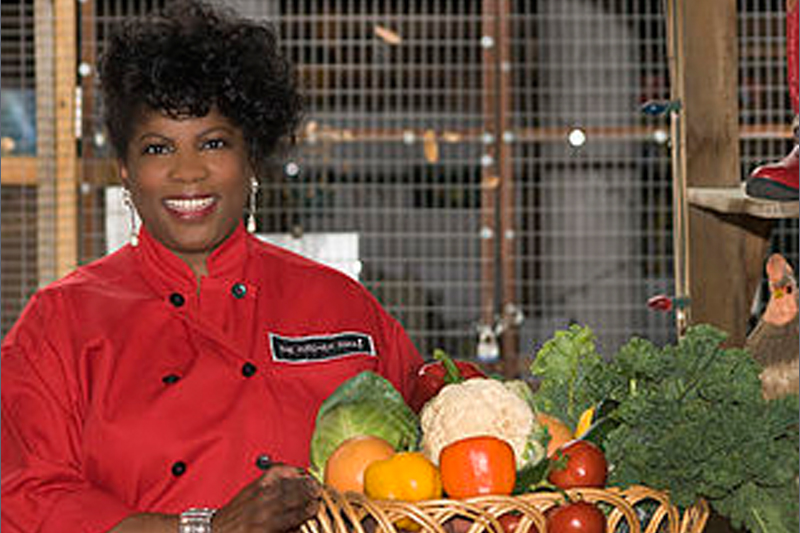KITCHEN DIVA
By Angela Shelf Medearis
Photo cutline: Depositphotos.com
Lose the Salt, Keep the Flavor
—
Sodium overload is a major health problem in the United States. The average American consumes about 3,400 milligrams of sodium a day, more than twice the 1,500 milligrams recommended by the American Heart Association. That’s largely due to our food choices. More than 75 percent of the sodium we eat comes from packaged and restaurant foods.
The American Heart Association has introduced the “Salty Six” to raise awareness of commonly eaten foods that may be loaded with sodium.
1) Breads and rolls — One slice can contain as much as 230 milligrams.
2) Cold cuts and cured meats — Deli or pre-packaged meats can have as much as 1,050 milligrams.
3) Pizza with meat — one slice can contain up to 760 milligrams.
4) Poultry — Avoid poultry products “enhanced” with a sodium solution. Three ounces of chicken nuggets can contain almost 600 milligrams.
5) Canned soup — One cup of chicken noodle soup has up to 940 milligrams.
6) Sandwiches — Meat, cheese, condiments and bread, up to 1,500 milligrams!
Here are a few tips on how to decrease your sodium intake.
When shopping for food:
* Choose packaged and prepared foods carefully. Compare labels and choose the product with the lowest amount of sodium (per serving).
* Pick fresh and frozen poultry that hasn’t been injected with a sodium solution. Check the fine print on the packaging for terms like “broth,” “saline” or “sodium solution.” In unseasoned fresh meats, typical sodium levels are 100 milligrams or less per 4-ounce serving.
* Choose condiments carefully. For example, soy sauce, bottled salad dressings, dips, ketchup, jarred salsas, capers, mustard, pickles, olives and relish can be sky-high in sodium.
* Choose canned vegetables labeled “no salt added” and frozen vegetables without salty sauces. When you add these to a casserole, soup or other mixed dish, there will be so many other ingredients involved that you won’t miss the salt.
When preparing food:
* Use onions, garlic, herbs, spices, citrus juices and vinegars in place of some or all of the salt to add flavor to foods.
* Drain and rinse canned beans (like chickpeas, kidney beans, etc.) and vegetables — this can cut the sodium by up to 40 percent.
* Cook pasta, rice and hot cereal without salt.
* Cook by grilling, braising, roasting, searing and sauteing to bring out the natural flavors in foods, reducing the need to add salt.
* Incorporate foods with potassium, like sweet potatoes, potatoes, greens, tomatoes and lower-sodium tomato sauce, white beans, kidney beans, nonfat yogurt, oranges, bananas and cantaloupe. Potassium helps counter the effects of sodium and may help lower your blood pressure.
At restaurants:
* Request that your menu selection be prepared without salt.
* Taste your food before adding salt. If you think it needs a boost of flavor, add freshly ground black pepper or a squeeze of fresh lemon or lime, and test it again before adding salt. Lemon and pepper are especially good on fish, chicken and vegetables.
* Watch out for foods described using the words pickled, brined, barbecued, cured, smoked, broth, au jus, soy sauce, miso or teriyaki sauce. These tend to be high in sodium. Foods that are steamed, baked, grilled, poached or roasted may have less sodium.
* Sample the many salt substitutes on the market. Some of them replace part or all of the sodium with potassium. Talk with your health-care professional about whether a salt substitute is right for you.
Over time, your taste buds will adjust to prefer less salt. Studies have shown that when people are placed on a lower sodium diet for a period of time, they begin to prefer lower-sodium foods, and the foods they used to enjoy taste too salty. Try it and see for yourself!
SALT-FREE FLAVOR BOOSTER
This combination of herbs and spices is a delicious way to replace salt without sacrificing flavor!
1/2 cup (4-ounces) salt-free Italian seasoning
1/3 cup garlic powder
1/3 onion powder
1 tablespoon parsley flakes
1 teaspoon ground black pepper
1/8 teaspoon stevia or sugar substitute
1/8 teaspoon ground cayenne pepper
1/8 teaspoon ground cloves
Combine all of the ingredients and mix thoroughly. Store in an airtight container away from heat and light. Makes about 1 1/4 cups.
***
Angela Shelf Medearis is an award-winning children’s author, culinary historian and the author of seven cookbooks. Her new cookbook is “The Kitchen Diva’s Diabetic Cookbook.” Her website is www.divapro.com. To see how-to videos, recipes and much, much more, Like Angela Shelf Medearis, The Kitchen Diva! on Facebook. Recipes may not be reprinted without permission from Angela Shelf Medearis.
(c) 2016 King Features Synd., Inc., and Angela Shelf Medearis

